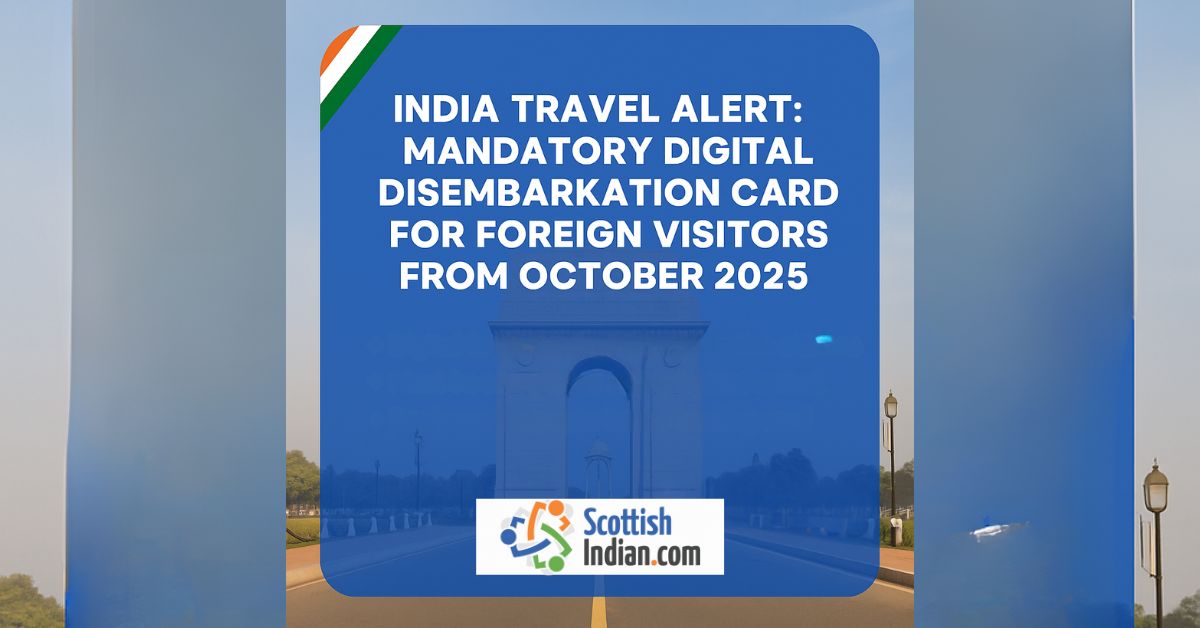Foreign travellers planning to visit India, whether for tourism, study, business, or medical reasons, should be aware of a significant change in immigration procedure coming into force on 1 October 2025: the introduction of a mandatory e-Arrival / Digital Disembarkation (DE) Card. This replaces the older paper-based landing card process for non-Indian citizens.
1. What’s changing?
From paper to digital
- Beginning 1 October 2025, foreign nationals arriving in India will no longer need to fill in a physical disembarkation (arrival) card at immigration counters.
- Instead, arriving non-Indian travellers must submit an e-Arrival Card / Digital Disembarkation (DE) Card online before their flight.
- The old paper option will likely be phased out over a transition period, possibly up to six months, but travellers are strongly encouraged to use the digital method.
Purpose & expected benefits
- The move is intended to streamline immigration clearance, reduce queue times, and make arrivals smoother for visitors. (The Times of India)
- It also aligns India with global trends: many countries already use digital arrival forms or pre-registration systems (e.g. Singapore, Thailand). (travelobiz)
- The digital system facilitates better data handling, reduces manual errors, and supports modernization of immigration control.
2. Who must fill it, and who is exempt?
Must fill: foreign nationals
This requirement applies to all foreign (non-Indian passport) travellers entering India, including tourists, business delegates, students, medical visitors, and conference attendees. (euronews)
Exemptions
- Indian citizens do not need to fill out the digital arrival card.
- OCI (Overseas Citizen of India) cardholders are also typically exempt from the requirement.
If you hold a foreign passport but also an OCI card, check the immigration guidance specific to your case to confirm whether you need to submit the e-Arrival Card.
3. When & where to submit the DE Card
Timeframe
- The digital arrival form must be completed within 72 hours before arrival.
- It is advisable not to wait until the last minute to avoid delays or technical issues.
How & where to submit
- The application will be available via the Indian Visa Online portal (indianvisaonline.gov.in), through a dedicated “e-Arrival / DE Card” section.
- There is also a mobile app, “Indian Visa Su-Swagatam,” through which you can complete the form.
- Upon successful submission, you’ll get a digital confirmation / receipt (often via email). This will serve as your e-Arrival record.
- A printed copy of the confirmation is recommended (even if not strictly required) for easier inspection at immigration.
During the transition period, some airports might still accept the paper card as backup, but this is not guaranteed.
4. What information is required?
The e-Arrival / Digital Disembarkation Card form will request standard traveller and trip details.
Typical fields include:
| Field Type | Examples / Details |
|---|---|
| Personal details | Full name, date of birth, nationality, passport number |
| Travel details | Flight/airline name, arrival date, last port of embarkation |
| Purpose of visit | Tourist, business, medical, study, etc. |
| Address in India | Hotel, hostel, or first stay location |
| Duration of stay | Intended number of days in India |
| Recent travel history | Countries visited in previous 6 days |
| Contact information | Email address, phone number |
There is no requirement to upload supporting documents (e.g. visa, tickets) as part of the form itself.
After submission, you receive confirmation, which you will present at immigration.
5. Transition & practical considerations
Transition period
- The government has indicated there may be a six-month period during which both the paper and digital systems operate in parallel.
- But even during that period, it is safer and faster to use the digital version.
Airline readiness & boarding checks
- Airlines flying into India will likely begin screening for the presence of a submitted e-Arrival Card before boarding.
- Travellers without the e-Arrival submission might face delays or boarding refusal until the form is completed.
Backups & tips
- Always print or screenshot your e-Arrival confirmation for show at immigration.
- Keep your visa & passport handy as the digital card is not a visa substitute. You still need a valid visa.
- If your arrival is delayed or your flight is rescheduled, double-check if your e-Arrival submission is still valid.
- Arriving via smaller or domestic airports? Confirm whether they have integrated the digital system yet or if they continue to accept paper forms (especially during the transitional phase).
6. How this affects different traveller types
Tourists & holiday visitors
You’ll simply fill out the e-Arrival form 1–3 days before your trip. Keep your confirmation ready when landing.
No change to visa rules. Just one extra step.
Students & academic visitors
If you’re flying to India for studies or research, the process is the same. The question “purpose of visit = study” will be one of the drop-down options. Make sure your address in India is your university or hostel.
Also ensure your e-Visa or student visa is valid before departure.
Business travellers & conference attendees
You may want to submit the form as soon as your travel is confirmed, but not more than 72 hours early.
Have your conference or business location registered as your address in India.
Medical treatment visitors
Same requirement. Use “medical” as purpose of visit, and state the hospital or clinic address in India.
Transit or connecting flights
Even if India is not your final destination and you’re just transiting, if you pass through immigration (or enter India’s airside), the digital arrival card will still apply. Check whether your itinerary requires you to clear immigration or stay airside.
This move is part of India’s larger Digital India mission. Thus, improving traveller experience through automation and reducing airport congestion.
For the latest updates, visa tips, and India–UK travel news, visit ScottishIndian.com — your trusted guide for global Desi travellers. 🌏🇮🇳






